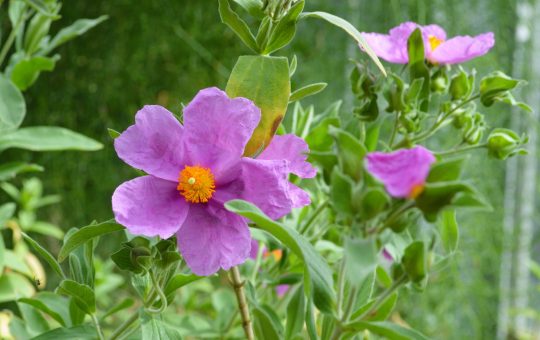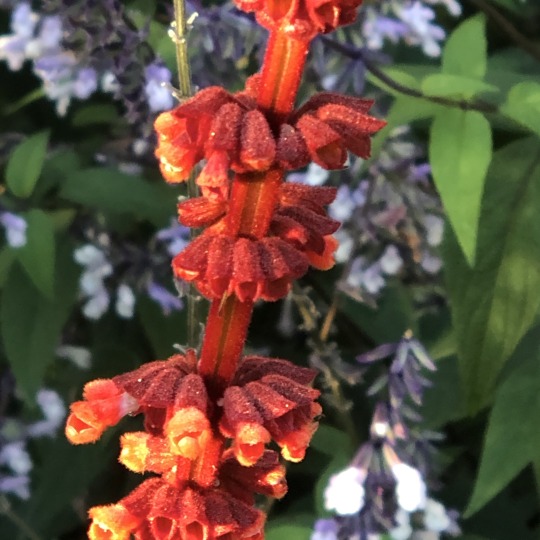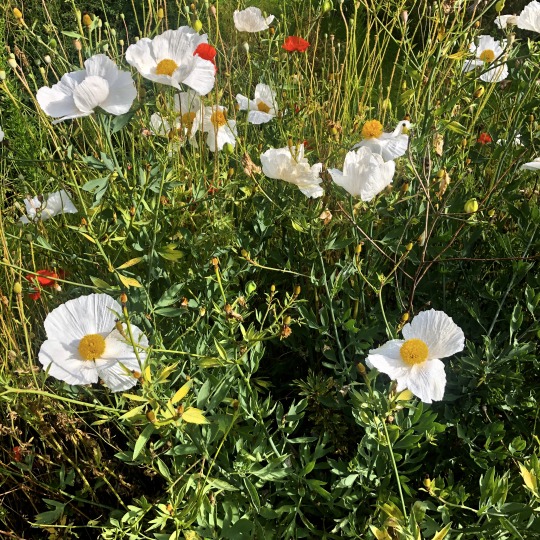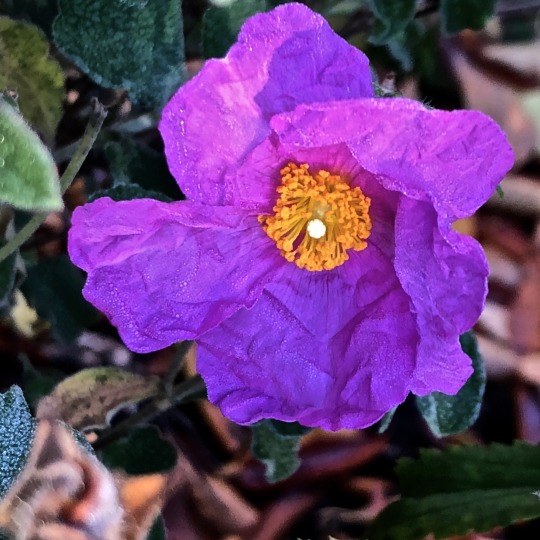#Cistus creticus
Text

Le ciste de Crète (Cistus creticus) est un arbrisseau aux fleurs roses chiffonnées caractéristique du maquis corse…
69 notes
·
View notes
Text

Cistus creticus
#photographie#photography#photografy#photographers on tumblr#aestethic#france#nature#original photographers#flower#nikkon#spring#cistus#ciste
23 notes
·
View notes
Text

Cisto di Creta (Cistus creticus L. (= C. incanus L.), Cistaceae
(elaborazione digitale)
#photographers on tumblr#digital image processing#original photographs#flowers#digital watercolor#Cistaceae
15 notes
·
View notes
Text
Κίστος: Το Ελληνικό φυτό με φαρμακευτικές ιδιότητες οι οποίες είναι γνωστές από την αρχαιότητα
O κίστος είναι ένα ελληνικό φυτό με φαρμακευτικές ιδιότητες οι οποίες είναι γνωστές από την αρχαιότητα. Πρόκειται για ένα ιδιαίτερα ανθεκτικό φυτό το οποίο φύεται σε διάφορα μέρη στην Ελλάδα. Η Κρήτη θα μπορούσε να θεωρηθεί ιδιαίτερη πατρίδα του, όπου έχει πάρει και το όνομά του ως κίστος ο «κρητικός» (Cistus creticus). Τα τελευταία 20 […]
Κίστος: Το Ελληνικό φυτό με φαρμακευτικές ιδιότητες οι…
0 notes
Text
Κίστος: Το Ελληνικό φυτό με φαρμακευτικές ιδιότητες οι οποίες είναι γνωστές από την αρχαιότητα
O κίστος είναι ένα ελληνικό φυτό με φαρμακευτικές ιδιότητες οι οποίες είναι γνωστές από την αρχαιότητα. Πρόκειται για ένα ιδιαίτερα ανθεκτικό φυτό το οποίο φύεται σε διάφορα μέρη στην Ελλάδα. Η Κρήτη θα μπορούσε να θεωρηθεί ιδιαίτερη πατρίδα του, όπου έχει πάρει και το όνομά του ως κίστος ο «κρητικός» (Cistus creticus). Τα τελευταία 20 […]
Κίστος: Το Ελληνικό φυτό με φαρμακευτικές ιδιότητες οι…
0 notes
Text
Κίστος: Το Ελληνικό φυτό με φαρμακευτικές ιδιότητες οι οποίες είναι γνωστές από την αρχαιότητα
O κίστος είναι ένα ελληνικό φυτό με φαρμακευτικές ιδιότητες οι οποίες είναι γνωστές από την αρχαιότητα. Πρόκειται για ένα ιδιαίτερα ανθεκτικό φυτό το οποίο φύεται σε διάφορα μέρη στην Ελλάδα. Η Κρήτη θα μπορούσε να θεωρηθεί ιδιαίτερη πατρίδα του, όπου έχει πάρει και το όνομά του ως κίστος ο «κρητικός» (Cistus creticus). Τα τελευταία 20 […]
Κίστος: Το Ελληνικό φυτό με φαρμακευτικές ιδιότητες οι…
0 notes
Text
Κίστος: Το Ελληνικό φυτό με φαρμακευτικές ιδιότητες οι οποίες είναι γνωστές από την αρχαιότητα
O κίστος είναι ένα ελληνικό φυτό με φαρμακευτικές ιδιότητες οι οποίες είναι γνωστές από την αρχαιότητα. Πρόκειται για ένα ιδιαίτερα ανθεκτικό φυτό το οποίο φύεται σε διάφορα μέρη στην Ελλάδα. Η Κρήτη θα μπορούσε να θεωρηθεί ιδιαίτερη πατρίδα του, όπου έχει πάρει και το όνομά του ως κίστος ο «κρητικός» (Cistus creticus). Τα τελευταία 20 […]
Κίστος: Το Ελληνικό φυτό με φαρμακευτικές ιδιότητες οι…
0 notes
Text
Kretische Zistrose
Cistus creticus
Familie: CistaceaeHerkunft: Mittelmeer- und Schwarzmeergebiete
Drogen:
LADANUM / Labdanum
das von der Pflanze ausgeschiedene HarzInhaltsstoffe: Harz, Ätherische Öle, Ester- und SesquiterpenesterVerwendung: Kosmetik, Essenzen und Räucherwerk
das Kraut
in der griechischen Volksheilkunde als Kräutertee bei diversen Beschwerden; Verarbeitung zu Pastillen, Tropfen, Cremes etc.

View On WordPress
1 note
·
View note
Text
Es el exudado pringoso del Cistus ladanifer y Cistus creticus, dos de las Jaras más populares y muy abundante en nuestros campos de España. El ládano es una oleorresina muy pegajosa, siendo uno de los ingredientes más demandados de la perfumería, su olor nos recuerda al ámbar gris, siendo también utilizado como fijador.
En la isla de Rodas las gotas de resina se obtenían de una forma muy curiosa, y era mediante cepillado del pelaje de ovejas y cabras, que se impregnaban al pastar entre las ramas de la jara.
En la actualidad el procedimiento es completamente distinto y la obtención del absoluto de ládano se suele hacer a través de la extracción con disolvente, mientras que su aceite esencial se obtiene mediante la destilación por arrastre de vapor, presentando esta esencia un potente aroma balsámico con notas ambaradas persistentes y un ligero matiz herbáceo.
#ladano #jara #ambargris #aceiteesencial #esential #perfume #destilacion #aroma #maktuk #antonioserranogarcia #labortorio #olor
0 notes
Photo

Cretan Rockrose
#cretan rockrose#illustration#botanical illustration#botanical#medicinal plants#history#jstor#crete#mediterranean#cistus creticus#science#pink#plants#nature
2 notes
·
View notes
Text
Address :Karaoli ke Dimitriou 10, Pireas, 185 31 GREECE
Phone : +30 21 0590 4753
Website : https://www.lelextea.com
Email : [email protected]
Herbal blends tea organic herbs of beauty health wellness
Monday 9AM–3PM
Tuesday 9AM–8PM
Wednesday 9AM–3:30PM
Thursday 9AM–8PM
Friday 8:30AM–8PM
Saturday 9AM–4PM
Sunday Closed
https://www.facebook.com/LelexTeas/
https://twitter.com/lelextea
https://www.linkedin.com/company/lelextea/
https://www.instagram.com/lelextea/
1 note
·
View note
Photo

Papery Perfection
#nature#macro#photographers on tumblr#original photographers#Cistus creticus#Cretan Rock Rose#Crete#Greece
59 notes
·
View notes
Text
26 October - 13 November 2020
These past few weeks have been an emotional roller-coaster. Back in September several friends, within 48 hours of each other, informed me about an amazing opportunity in the south of France. I was so touched that people were looking out for me, knowing I’ve been aching to move to somewhere warmer, more Mediterranean. I hesitated for a week because the job announcement on a garden designer’s Facebook page stated French was important. I’ve studied French for a long time and I still have a long way to go to fluency. Again, later in the week, another friend from Kew mentioned it and knew the garden personally.
So I took the plunge and sent my CV, in French, to the garden designers. They liked it well enough to pass it to the client. A week later I had my first phone interview and it went well. Now I was super excited and could hardly sleep. On paper this job sounds really good. I checked out some You Tube videos on the garden designer, their preferred maintenance contractor and the nursery they use. I only became more interested and excited.
Plant ident 30 October
Lamiaceae Salvia africana-lutea syn. of Salvia aurea
Lamiaceae Salvia canariensis
Lamiaceae Salvia confertiflora
Lamiaceae Salvia elegans ‘Honey Melon’
Lamiaceae Salvia greggii x serpyllifolia
Lamiaceae Salvia greggii ‘Stormy Pink’
Lamiaceae Salvia involucrata
Lamiaceae Salvia microphylla var. neurepia ‘Oxford’
Lamiaceae Salvia ‘Nel’
Lamiaceae Salvia ‘Phyllis Fancy’
Plant of the week
Lamiaceae Salvia confertiflora Pohl

common name(s) - Sabra spike sage
synonym(s) - Salvia confertiflora var. angustifolia J.A.Schmidt; Salvia confertiflora var. brachyantha Pohl; Salvia rufa Epling
conservation rating - none
native to - Brazil
location - salvia walk, accession 2019-0398
leaves - deciduous, pungently-scented, ovate
flowers - slender spikes of small scarlet flowers, covered with velvety red-brown hairs, with the stems of the inflorescence and the calyx also having a red-brown colour, in late summer and autumn
habit - a tender bushy perennial to 1.2m tall, becoming woody at the base
habitat - tropical, summer rains, dry winters
pests - slugs, snails, capsid bug, rosemary beetle, leafhoppers
disease - generally disease-free
hardiness - to 1ºC (H2)
soil - loam, chalk or sand, well-drained
sun - full sun, sheltered
propagation - seed in containers in a cold frame in spring; softwood cuttings in spring or early summer or semi-ripe cuttings in late summer or autumn with bottom heat
pruning - cut down if hit by frost
nomenclature - Lamiaceae - lamium - gullet, the name in Pliny refers to the gaping mouth of the corolla; Salvia - healer, the old Latin name for sage with medicinal properties; confertiflora - with dense or crowded flowers
NB - first discovered in 1833 by the Austrian naturalist, Johann Baptist Emanuel Pohl in the Serra dos Órgãos, state of Rio de Janeiro. Pohl sent specimens back to botanical gardens of Europe where it was popular not only for its dramatic colour, but also for its prolific flowering well up to the time of frost
References, bibliography:
Gledhill, David, (2008) “The Names of Plants”, fourth edition; Cambridge University Press; ISBN: 978-0-52168-553-5
IUCN [online] http://www.iucnredlist.org/search [18 Nov 20]
Plant List, The [online] http://www.theplantlist.org/tpl1.1/record/kew-182420 [18 Nov 20]
Plants of the World [online] http://plantsoftheworldonline.org/taxon/urn:lsid:ipni.org:names:456011-1 [18 Nov 20]
Royal Horticultural Society [online] https://www.rhs.org.uk/Plants/16324/i-Salvia-confertiflora-i/Details [18 Nov 20]
Wikipedia [online] https://en.wikipedia.org/wiki/Salvia_confertiflora [18 Nov 20]
About ten days later I received an email inviting me to meet with his wife, here in London, for a second interview. That took place one evening after work. Again, the conversation went very well and it turns out we have a friend in common - who would have imagined!
The following week, after posting some tea to my sister in LA, I received the call offering me the position. Again, no sleep that night!
While all of this was happening, my tinnitus has been acting up too. I have also experienced a few bouts of vertigo, which is quite rare for me.
So that Friday, two weeks ago, I tendered my resignation. I asked to take my remaining annual leave as part of my notice period which meant I only had two weeks left in the garden. This will give me next week to sort my packing and I’ll fly to Nice next Saturday, 21 November. This will give me one week to work with the person who is leaving. I’ve never had such a fantastic opportunity for a week-long hand-over.
Plant ident 6 November this week was a review of the past four weeks, those were my favourites at Kew because it helped me retain names that would otherwise have just never stuck.
Plant of the week
Cucurbitaceae Momordica charantia L.

common name(s) - bitter melon; bitter apple; bitter gourd; bitter squash; balsam-pear
synonym(s) - Cucumis argyi H.Lév.; Cucumis intermedius M.Roem.; Momordica charantia subsp. abbreviata (Ser.) Greb.; Momordica charantia f. abbreviata (Ser.) W.J.de Wilde & Duyfjes; Momordica charantia var. abbreviata Ser.; Momordica charantia var. longirostrata Cogn.; Momordica charantia var. muricata (Willd.) Chakrav.; Momordica chinensis Spreng.; Momordica elegans Salisb.; Momordica indica L.; Momordica muricata Willd.; Momordica sinensis Spreng.; Momordica thollonii Cogn.; Sicyos fauriei H. Lév.
conservation rating - none
native to - tropical and subtropical Old World
location - tropical corridor, accession 2020-0110
leaves - simple, alternate leaves 40 to 120mm across, with three to seven deeply separated lobes
flowers - separate yellow male and female flowers; in the Northern Hemisphere, flowering occurs during June to July and fruiting during September to November
habit - very vigorous, tendril-bearing vine to 5m
habitat - hot humid areas of the tropics and subtropics; savannah and bush; common in coastal thickets, along creeks and streams, and in lowland forest margins
pests - aphids
disease - downy mildew, powdery mildew, Fusarium wilt, target leaf spot, root-knot
hardiness - to 5ºC (H1c)
soil - rich in organic matter with 2m to 2.5m of rainfall annually
sun - full sun
propagation - seed - sow in situ; seedlings emerge five to seven days after sowing, but fresh seed often shows dormancy which is very hard to break and can last for some months
pruning - none
nomenclature - Cucurbitaceae - cucurbita - Latin name for the bottle-gourd; Momordica - bitten, the jagged seeds of balsam pear appear to have been nibbled; charantia - graceful, the pendent fruits
NB - is a laxative, diuretic herb that soothes irritated tissue, lowers fevers, kills parasites and cleanses toxins from the system; probably also a uterine stimulant; the fruit is most often eaten green, or as it is beginning to turn yellow. At this stage, the fruit's flesh is crunchy and watery in texture, similar to cucumber, chayote or green bell pepper, but bitter. The skin is tender and edible.
References, bibliography:
Gledhill, David, (2008) “The Names of Plants”, fourth edition; Cambridge University Press; ISBN: 978-0-52168-553-5
IUCN [online] http://www.iucnredlist.org/search [20 Nov 20]
Plant List, The [online] http://www.theplantlist.org/tpl1.1/record/kew-2372864 [20 Nov 20]
Plants of the World [online] http://plantsoftheworldonline.org/taxon/urn:lsid:ipni.org:names:293413-1 [20 Nov 20]
Useful Tropical Plants [online] http://tropical.theferns.info/viewtropical.php?id=Momordica+charantia [20 Nov 20]
Wikipedia [online] https://en.wikipedia.org/wiki/Momordica_charantia [20 Nov 20]
I worked the weekend of 7/8 November, my last weekend duty.
I’ve been taking private French lessons twice a week for the past three weeks. François has been taking an hour out every weekend to help me with my French. I’m hoping once I start living in the language it will come together. Lucien organised my French mobile number, so it will be ready to use when I land.
During these few weeks in the garden leaves have been falling and falling and falling. Al spends most mornings blowing leaves into big piles. He’s also agreed to stay on through the end of January.
Plant ident 13 November ferns
Aspleniaceae Asplenium trichomanes
Aspleniaceae Asplenium scolopendrium
Blechnaceae Blechnum cordatum
Dennstaedtiaceae Pteridium aquilinum
Dicksoniaceae Balantium antarcticum syn. Dicksonia antarctica
Dryopteridaceae Polystichum setiferum
Polypodiaceae Adiantum venustum
Polypodiaceae Microsorum diversifolium syn. Phymatosorus pustulatus subsp. pustulatus
Polypodiaceae Polypodium interjectum
Pteridaceae Coniogramme emeiensis
I gave Olivia a thorough hand-over of my beloved tropical glasshouse. I’m sure it is in good hands, and under the always watchful eye of Jess.

Jess and I gave the tropical corridor it’s winter pruning on Thursday.
Nell has allowed me to work on several projects on the database I’ve been trying to complete. I added to my predecessor’s manual for the plant records manager. It is quite comprehensive. I hope my replacement finds it helpful and continues to update it as the roll changes.
Wednesday, when Jill was in the garden, I asked her to create a herbarium specimen of the Romneya coulteri for me, also being a California native.

Friday, 13 November, saying goodbye... I made my way to Victoria in the morning, before work, to purchase one last social from Ole & Steen. After work we indulged in cheese, beers and Nell gave a very nice speech.
Mary Ellen painted this for me, and the plant and secateurs were gifts from colleagues.

The evening concluded with a stint in the jacuzzi - so very relaxing.

Plant of the week - a foreshadow of the next garden in which I shall be working
Cistaceae Cistus creticus L.

common name(s) - Cretan rockrose
synonym(s) - Cistus complicatus Spruner ex Nyman; C. creticus f. albus (O.E.Warb.) Demoly; C. creticus f. flavus Demoly; C. creticus subsp. trabutii (Maire) Dobignard; C. cupanianus C.Presl; C. dunalianus Sweet; C. garganicus Ten.; C. × incanus subsp. creticus (L.) Heywood; C. incanus subsp. creticus (L.) Heyw.; C. ladaniferus Stokes; C. polymorphus Willk.; C. rotundifolius Sweet; C. tomentosus Lam. [Illegitimate]; C. undulatus Moench; C. villosus L.; C. villosus f. albus O.E.Warb.; C. villosus var. creticus (L.) Boiss.; C. villosus var. rotundifolius (Sweet) Grosser; C. villosus var. trabutii Maire; C. villosus var. undulatus Grosser; C. vulgaris Spach; Ladanium officinarum Spach; Ladanum verum Raf.
infraspecific taxa - Cistus creticus subsp. corsicus (Loisel.) Greuter & Burdet; Cistus creticus subsp. eriocephalus (Viv.) Greuter & Burdet
conservation rating - none
native to - central and eastern European Mediterranean to Jordan
location - history beds, accession 1996-0376
leaves - shaggily hairy stems, leaves are slightly scented
flowers - variable in shade from deep purple-pink to rose pink, to 6cm across, with a yellow centre
habit - very variable, small, bushy, evergreen shrub, to perhaps 1.5m tall; highly branched shrub that measures between 30 to 140 cm with a more or less creeping stem but without actually taking root in the ground, with little strength to stay upright
habitat - distributed in calcareous romerales that inhabit soils with sandy characteristics; can be found growing near oak forests on the coast
pests - generally pest-free
disease - may suffer from nutrient deficiency when grown on very alkaline soils
hardiness - to -10ºC (H4)
soil -well-drained
sun - full sun, sheltered
propagation - seed, sow as soon as ripe and keep in cold frame or sow in spring; softwood cuttings in summer
pruning - does not respond well to hard renovation pruning
nomenclature - Cistaceae - Cistus - capsule, rock roses are conspicuous in fruit; creticus - from Crete, Cretan
NB - traditional herbal medicine, the leaves of Cistus have been used in the treatment of skin and inflammatory diseases (Hudson, 2009). Recent scientific research has confirmed the validity of this traditional herbal knowledge through studies that have demonstrated that Cistus leaf extractives have powerful antibacterial, antifungal, antiviral, and biofilm-breaking qualities (Rebensburg et al, 2015).
References, bibliography:
Gledhill, David, (2008) “The Names of Plants”, fourth edition; Cambridge University Press; ISBN: 978-0-52168-553-5
IUCN [online] http://www.iucnredlist.org/search [19 Nov 20]
Plant List, The [online] http://www.theplantlist.org/tpl1.1/record/kew-2723343 [19 Nov 20]
Plants of the World [online] http://plantsoftheworldonline.org/taxon/urn:lsid:ipni.org:names:168230-1 [19 Nov 20]
ProHealth [online] https://www.prohealth.com/library/cistus-a-natural-antibiotic-antiviral-and-biofilm-buster-6292 [19 Nov 20]
Royal Horticultural Society [online] https://www.rhs.org.uk/Plants/22292/Cistus-creticus/Details [19 Nov 20]
Warbleton Council [online] https://warbletoncouncil.org/cistus-creticus-13547 [19 Nov 20]
SARS-CoVid-2 update (active cases only) 2 November 2020

SARS-CoVid-2 update (active cases only) 8 November 2020

SARS-CoVid-2 update (active cases only) 16 November 2020

0 notes
Text



C – Cistus creticus L. (= C. incanus L.) – Cisto di Creta (Cistaceae)
13 notes
·
View notes
Quote
CHAP. 38.
Another ſweet ſmelling ball.
Take two ounces of pure Labdanum, one ounce and a half of Bengroine one ounce of Willow coals of Storax Calamita, ſix drams, two drams, a peece of Marjoram, and yellow or red Sanders, of red Roſes and Calainus Aramaticus, two ſcruples a peece, then take ſix drams of oyl of ſweet Almonds and as much of Bengroin, with half an ounce of Storax Calamita ſithe theſe things together then put thereto ſix drams of Roſe water. Then ſtrain it, and let that which is ſtrained, be ſoft made with two ounces of white wax, and put to it of Storax liquida, one dram, make it like as Cereatum, or plaiſter incorporate theſe together with a hot peſtle putting thereto a dram and a half of muſk.
W. J. Gent. A Collection of Seven and Fifty approved Receipts Good against the Plague. 1665.
Labdanum aka ladanum, ladan or ladanon. A sticky brown resin obtained from the shrubs Cistus ladanifer (western Mediterranean) and Cistus creticus (eastern Mediterranean), a species of rockrose. It was historically used in herbal medicine and is still used in the preparation of some perfumes and vermouths. (Wikipedia)
Bengroin / Bengroine is unknown; possibly a corruption of Benzoin (aka “Benjamin”), a resin of the styrax genus; frankincense.
Willow coals of Storax Calamita: in later “receipts” these elements are treated as separate entities. Willow in its many varieties is a common tree in northern Europe known for its analgesic properties. Storax (aka Styrex) is a shrub productive of a resin used in incense. Calmita is the island of Elba.
Marjoram (Origanum majorana) aka oregano: a middle eastern semi-annual aromatic herb still used in food preparation.
Yellow or Red Sanders: sandalwoods, probably aromatic varieties, from India and Southeast Asia.
Calainus Aramaticus: unknown. Possibly the text is corrupted. Calamus Aramaticus, a species of aromatic grass from India formerly used in the preparation of absinthe, may be intended.
Storax liquida: A rectified spirit from the wood and inner bark of Liquidamber orientalis, a tree of Asia Minor, or L. styraciflua (family Hamamelidaceae); still used by herbalists in the treatment of chronic inflammation of the mucous membranes, and externally for scabies. Storax Liquida used in the 17th century possibly originated in Mexico. Further details at https://www.botanical.com/botanical/mgmh/s/storax93.html
Cereatum: unknown in this context; apparently a paste or plaster. These were used in a kerchief, sponge or mask, or possibly as a chest rub clear the lungs, as some modern aromatic preparations are used.
1 note
·
View note
